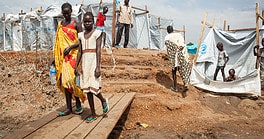ANNUAL SUPPLEMENT: AFRICA 2013
By Dan Keeler
Developed-markets watchers hope tightening trade ties and increasing foreign direct investment will help ease tensions in North Africa.
Two years after the Arab Spring swept through North Africa and beyond, toppling entrenched regimes and spreading a sense of democracy, freedom and optimism, the region’s prospects were beginning to look rosy. Early this year, economic growth was beginning to pick up and the efforts of those who had fought to depose dictators seemed to be bearing fruit.
But as Global Finance was going to press, North Africa was in turmoil. Two political assassinations in six months had triggered angry demonstrations in Tunisia and prompted the moderate Islamist government to agree to consider resigning in favor of a nonpartisan “national unity” government. In Egypt the brutal crackdown on demonstrators opposing the ouster of a democratically elected president, the military takeover of government and the demonizing of the Muslim Brotherhood were threatening to ignite widespread violence. Sandwiched between the two, Libya was dealing with its own crisis. Unrest and lawlessness were triggering disruption at the country’s key ports, slashing oil exports to as low as a sixth of their normal level and raising questions about the stability of the country’s government.
TRADE PACTS
Amid so much turmoil, Morocco and Algeria present relative oases of calm. Although they still have not reached agreement over the disputed territory of Western Sahara, after years of enmity the two countries appear to be heading for reconciliation. Morocco, in particular, has been pushing for greater regional cooperation and integration and has been working to build its trade links with Europe and other regions, such as West Africa.
It is through trade that the European Union is hoping to help North Africa’s troubled fledgling states recover their poise and develop their economies. As part of its “neighborhood policy,” the EU is working with countries around the bloc’s periphery to create a more productive trading relationship. It has focused recent North African efforts on building a trade pact with Morocco.
EU negotiators are hoping the Morocco pact will become a model for other countries in the region. In a recent discussion of the progress of the neighborhood policy, the commissioner in charge of the project, Štefan Füle, said he was optimistic that Tunisia would begin talks that would mirror the EU’s discussions with Morocco: “Tunisia offers good prospects of a successful democratic transition, and the EU must remain engaged to support this country,” he commented.
Tunisia’s trade with the EU illustrates the importance of Europe to the economies of North Africa. Of Tunisia’s total of nearly €12 billion ($15.6 billion) in exports in 2011, almost €10 billion went to the EU. Four-fifths of the country’s FDI originates in Europe. Morocco is also heavily reliant on Europe, with 60% of its FDI originating there.
The EU makes no secret of its hope that the countries of North Africa will eventually form part of the economic union. Noting that the pending trade agreement with Morocco would include a wide range of services and investments, the EU said it hoped the pact would lead to “the gradual integration of the Moroccan economy into the EU single market.”
Over the past decade, trade between North Africa and the fast-growing emerging markets—particularly Brazil, Russia, India and China—has also deepened considerably: North Africa represents both a source of sorely needed commodities for the BRICs and a market of some 170 million people for their products.
Perhaps a more compelling reason for the BRICs to invest in North Africa is the fact that, through their trade links, North African countries present another channel of access to the lucrative consumer markets of Europe and beyond. Tempted by the region’s free-trade agreements, not just with Europe but also with several countries in the Americas, companies from the BRICs have poured billions into factories across North Africa. China has been leading the charge. Brazil and India have also been highly active, as have such non-BRIC countries as Turkey and South Korea.
In its April 2013 report “Arab Countries in Transition,” the International Monetary Fund noted that Arab Spring countries are struggling with an immensely difficult balancing act as they try to maintain political stability while fulfilling the economic and social hopes of their populations. A key part of the solution, the IMF believes, is promoting international trade, as well as attracting more FDI inflows to the countries of the Middle East and North Africa region. In order to do that, MENA countries must “deepen trade integration with the advanced economies, fast-growing emerging markets, and among countries within the region,” the report asserts.
Whether growing trade and growing FDI will ease tensions in the region by boosting economic growth or add to unease by pushing out domestic businesses remains to be seen. But there is no doubt the region will be in transition for some time to come.




